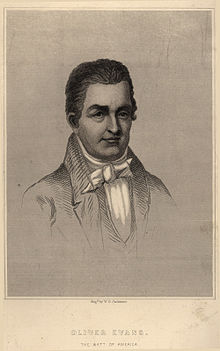Oliver Evans
Oliver Evans (born September 13, 1755 in Newport , Delaware Colony , † April 15, 1819 in Pittsburgh ) was an American inventor and entrepreneur .
Life
He designed various machines such as the first automatic flour mill , a conveyor system , the "Hopper Boy", a machine that served the meal cooling and is used today in a similar design in coffee roasting and two steam-powered excavator whose second, the port excavators Orukter Amphibolos , both was the first vehicle in the United States that could move under its own power, as was the first amphibious vehicle . His improvements to the high pressure steam engine and his description of a refrigerator that works with steam are also important .
With his wife, Kathy, he had two sons, John and Theophilus Oliver.
Evans came from a family of farmers . He learned the job of a wheelwright and from the end of 1772 began to work with the Newcomen steam engine, which he wanted to improve so much that it could be built into a vehicle. From 1778 he served as a soldier in the American War of Independence (1775–1783). He then opened a shop in Tuckahoe Creek ( Maryland ). He dealt with steam-powered machines and with an automatic flour mill and again and again with a vehicle that could move itself. To do this, he improved the high - pressure steam engine , which he enforced against many opposition and opponents such as the inventor of the low- pressure steam engine , James Watt (1736–1819), or the architect Benjamin Henry Latrobe . Orukter Amphibolos was completed at the end of 1804 and presented to the public in the second week of July 1805.

Extract from Meyer's Konversationslexikon from 1888:
"Evans (spr. Éwens), 1) Oliver, mechanic, b. 1755 at Newport in Delaware, was apprenticed to a Wagner and after a barely survived apprenticeship he constructed a spinning machine and a mill. He also designed a high-pressure machine without condensation, which he recommended for moving cars, and of which he sent drawings to England in 1787 and 1794. Linked to his brothers, he improved the details of the grinding mills, and in 1786 he sought the patenting of a steam mill and a steam wagon that were to be operated with high steam pressure. In 1800 he began building such facilities, and in 1804 he built a steam excavator, which was driven by a paddle wheel moved by the steam engine. The same steam engine was previously used as a locomotive to transport the excavator from the factory to the water. E., next to Watt, occupies a very prominent position in the history of the steam engine, but he was not promoted to the same extent by the circumstances, and he was unable to carry out epoch-making ideas, such as the use of the steam engine to move ships and trucks because no capitalist supported him. He designed the elevator , the conveyor, the flour cooler, the pourer etc. for the milling industry . He died April 19, 1819 in Pittsburgh. E. wrote: 'The young millwright's and miller's guide' (New York 1795, 4th ed. 1821; after the 5th ed. French by Bénoit, par. 1830); 'Guide for the mechanical engineers etc.' (1805; French by Doolittle, that. 1822). "
A serious setback was the non-renewal of his milling patents in 1808, which deprived him of his livelihood. He finished his second book, which was aimed at designers of steam engines. In 1808, the US Congress re-established its rights with validity until 1830.
He spent his last years building the Mars Iron Works and the Fairmount Engine Works . Gradually his steam engines could be sold.
His wife died in 1816. In 1818 he married Hetty Ward of the Bowery in New York. There he fell ill with pneumonia in 1819. Unlike Meyer's Konversationslexikon, he died here of a heart attack after the news that the Mars Iron Works had burned down. The fire had been started deliberately by one of the company's apprentices, apparently for no deeper reason. All of Evans' plans and drawings, and thus his life's work, fell into flames.
Works
- The Young Mill-wright's and Miller's Guide (Manual Müller)
- Guide for the mechanical engineers etc.
- Patent Right Oppression Exposed; or Knavery Detected , a satire in verse about his experience with patent law; published under a pseudonym
Remarks
- ^ According to Kimes: Pioneers, Engineers, and Scoundrels: The Dawn of the Automobile in America , pp. 3–5, Evans married Sarah Tomlinson , a Delaware farmer's daughter, in 1783 . Accordingly, the family had 7 children.
literature
- D. Ogden, G. Bost: Ganzel & Wulff - The Quest for American Milling Secrets . TIMS Bibliotheka Molinologica, Volume 20, 2010, ISBN 978-92-9134-025-5
- Beverly Rae Kimes: Pioneers, Engineers, and Scoundrels: The Dawn of the Automobile in America. Published by SAE (Society of Automotive Engineers) Permissions, Warrendale PA 2005, ISBN 0-7680-1431-X . (Hardcover, English)
- Evans, Oliver . In: Encyclopædia Britannica . 11th edition. tape 10 : Evangelical Church - Francis Joseph I . London 1910, p. 2 (English, full text [ Wikisource ]).
Web links
- Literature by and about Oliver Evans in the catalog of the German National Library
Individual evidence
- ↑ Oliver Evans . In: Meyers Konversations-Lexikon . 4th edition. Volume 5, Verlag des Bibliographisches Institut, Leipzig / Vienna 1885–1892, p. 948.
| personal data | |
|---|---|
| SURNAME | Evans, Oliver |
| BRIEF DESCRIPTION | American inventor |
| DATE OF BIRTH | September 13, 1755 |
| PLACE OF BIRTH | Newport , Delaware |
| DATE OF DEATH | April 15, 1819 |
| Place of death | Pittsburgh |

